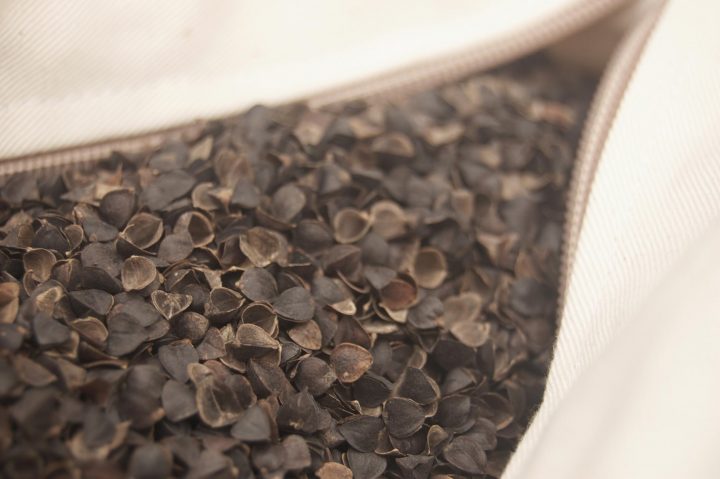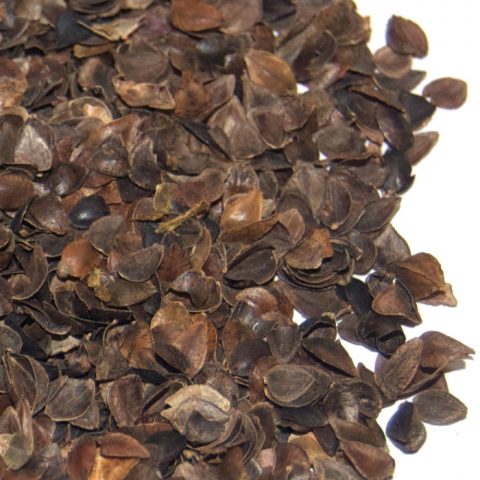 After purchasing a small buckwheat pillow and falling in love with it, I set out to make my own standard sized (20×26″) buckwheat pillow. This pillow ultimately became the first Hullo buckwheat pillow prototype. I quickly found high-quality fabrics and tons of different tough-looking zippers, but locating bulk buckwheat hulls proved to be very time consuming.
After purchasing a small buckwheat pillow and falling in love with it, I set out to make my own standard sized (20×26″) buckwheat pillow. This pillow ultimately became the first Hullo buckwheat pillow prototype. I quickly found high-quality fabrics and tons of different tough-looking zippers, but locating bulk buckwheat hulls proved to be very time consuming.
Buckwheat hulls are available in many different varieties and qualities. My goal was simple: find the best ones for use in a pillow.
Firstly, I narrowed the search considerably by considering only USA produced buckwheat hulls. Our company, Hulltex, is American, based in Duluth, Minnesota. It’s very important to us that we support locally owned farms and companies, particularly during these challenging economic times.
Imported Bulk Buckwheat Hulls
China, Russia, Kazakhstan, Ukraine and and several other eastern european countries are big exporters of buckwheat. There are certainly good prices to be found, but they are typically not produced using the same high standards practiced in the USA.
Imported hulls come to North America via the oceans. The ocean shipping industry has unfortunately caused a substantial amount to climate change. More than 3% of global carbon dioxide emissions are a result of ocean shipping.
Manufacturers of buckwheat pillows that utilize imported buckwheat hulls will sometimes market their hulls as having been “roasted.” This term refers to a process required by the US government to remove any potential contaminants the product might contain prior to being distributed to American markets; it prevents the spread of plant pests and diseases. The hulls are subjected to high heat. This process unfortunately eliminates some moisture content, making the hulls a bit more brittle, dusty and prone to flattening out.
Bulk Buckwheat Hulls – Sample #1

These certified organic buckwheat hulls have been crushed flat, making them less effective for use in a pillow.
I ordered our first sample buckwheat hulls thinking that they’d be perfect. They were certified organic and a good price! When they arrived in the mail, they weren’t quite what I’d hoped. The hulls weren’t intact and were crushed into small pieces.
So what’s wrong with crushed hulls? (A few minor things if you’re a pillow nerd):
- Using this type of hull will result in a pillow that doesn’t hold its shape as well as it could. The flattened hulls have lost much of their rough edges; they do not grip one another as well as intact ones do.
- There’s much less space between the buckwheat hulls when they’ve been crushed flat. The benefit of air circulation (and a cool pillow) is diminished.
- When crushed, buckwheat hulls, especially if they’re very dry, will break into very small pieces, creating dust. Even with vacuum-cleaning, dust can remain with the larger pieces of buckwheat hulls. These small pieces can work their way through a thin pillowcase and make a mess.
- Buckwheat hull pillows are not light. Flattened hulls are more dense than intact ones and will increase the weight your already hefty pillow.
Some marketers of buckwheat pillows use this characteristic to their advantage claiming that they’ve been “pre-flattened” or “polished.”
It’s our belief that intact hulls are superior, but there are two distinct, albeit small, advantages to crushed buckwheat hulls:
- They will make less noise when the pillow is moved.
- They will retain their volume longer. Thus, your pillow’s loft will be more consistent over time. Flattened hulls are already lacking their natural loft, so you can adjust your pillow’s thickness once and it won’t change much with use.
Bulk Buckwheat Hulls – Sample #2
My second sample of buckwheat hulls wasn’t much more successful than the first. Another certified organic variety with a much higher price tag arrived at my door step. I tore into the package and was disappointed to see the tiny little hulls contained. While completely intact, the individual hulls were tiny compared to some of the larger varieties available. Being so small, these were quite dense; they were heavier and restricted air flow much like the crushed buckwheat hulls in my first sample.
Finding the Best Bulk Buckwheat Hulls
I got a several other samples with similar issues — they were all less than ideal for one reason or another. Finally a sample came that was perfect… well almost. The buckwheat hulls were:
- completely intact,
- large enough to allow good air circulation, and
- mostly dust free.
Do Organic Buckwheat Hulls Matter?
The one catch was that they weren’t certified organic. Does that matter? After pouring through available data, we determined that it was of little importance that the buckwheat hulls be certified. Buckwheat grows very well without requiring noxious fertilizers or pesticides that are commonly used for other crops. Thus, it is most often very close to the definition of organic without actually being certified organic.
In the end, it wasn’t a difficult decision. I decided that it was better to use buckwheat hulls with superior physical characteristics rather than rely on the insignificant label applied to potentially inferior pillow fill… even if they costed more!
In summary, without seeing the buckwheat hulls up close in person, it’s very difficult to know what you’re getting. We’ve done that for you. If you’re in the market for buckwheat hulls for use in a pillow, look no farther. We’ve selected the best we could find and use them in every Hullo™ we ship. We guarantee you’ll agree. If you’re unhappy for whatever reason, just ship them back to us and we’ll refund you the purchase price.







